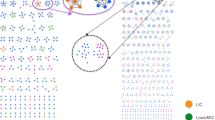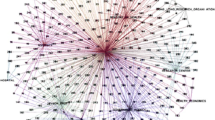Abstract
We present an analysis of sectoral collaboration for cardiovascular medical device development in South Africa over a 15 year period. The main objectives were to identify the nodes (organizations) and sectors that influence the behaviour of the cardiovascular device development network; to identify the types of collaboration that exist within the network; to quantify the extent of collaboration within the network; and finally to analyse the changes in overall collaboration over time. Collaboration across four sectors was considered: healthcare services, industry, universities, and lastly, science councils and facilities. Author affiliations, extracted from journal articles, were used to generate collaboration networks. Network metrics—degree centrality, betweenness centrality and graph densities—and network graphs were produced using network visualization software (UCINET) in order to identify the influential nodes and sectors, as well as to measure the extent of collaboration within and between sectors. The university and healthcare services sectors were found to make the largest contribution to the development of cardiovascular medical devices in South Africa. Collaboration between universities and healthcare service nodes was the most prevalent type of cross-sector collaboration. Universities were found to be potential key players in the transmission of information across the network, with greater potential than the remaining sectors to form new collaborations with isolated nodes, thereby enhancing device development activity. Foreign nodes played a role in connecting local nodes which would otherwise have been isolated. Overall, collaboration across sectors has increased over the 15 year period, but science councils and industry still have room to become more involved by partnering with the dominant sectors.



Similar content being viewed by others
References
Abbasi, A., Hossain, L., & Leydesdorff, L. (2012). Betweenness centrality as a driver of preferential attachment in the evolution of research collaboration networks. Journal of Informetrics, 6(3), 403–412. doi:10.1016/j.joi.2012.01.002.
Ankrah, S. N., Burgess, T. F., Grimshaw, P., & Shaw, N. E. (2013). Asking both university and industry actors about their engagement in knowledge transfer: What single-group studies of motives omit. Technovation, 33(2–3), 50–65. doi:10.1016/j.technovation.2012.11.001.
Balconi, M., & Laboranti, A. (2006). University–industry interactions in applied research: The case of microelectronics. Triple Helix Indicators of Knowledge-Based Innovation Systems, 35(10), 1616–1630. doi:10.1016/j.respol.2006.09.018.
Barabási, A. L., Jeong, H., Néda, Z., Ravasz, E., Schubert, A., & Vicsek, T. (2002). Evolution of the social network of scientific collaborations. Physica A: Statistical Mechanics and Its Applications, 311(3), 590–614. doi:10.1016/S0378-4371(02)00736-7.
Batool, K., & Niazi, M. A. (2014). Towards a methodology for validation of centrality measures in complex networks. PLoS ONE, 9(4), e90283. doi:10.1371/journal.pone.0090283.
Borgatti, S., Everett, M., & Freeman, L. (2002). UCINET 6 for windows, software for social network analysis (Version 6). Harvard MA: Analytic Technologies.
Chen, D., Lü, L., Shang, M.-S., Zhang, Y.-C., & Zhou, T. (2012). Identifying influential nodes in complex networks. Physica A: Statistical Mechanics and Its Applications, 391(4), 1777–1787. doi:10.1016/j.physa.2011.09.017.
Chinchilla-Rodríguez, Z., Benavent-Pérez, M., de Moya-Anegón, F., & Miguel, S. (2012). International collaboration in Medical Research in Latin America and the Caribbean (2003–2007). Journal of the American Society for Information Science and Technology, 63(11), 2223–2238. doi:10.1002/asi.22669.
Freeman, R., Ganguli, I., & Murciano-Goroff, R. (2014). Why and wherefore of increased scientific collaboration (NBER Chapters). National Bureau of Economic Research, Inc. Retrieved from http://econpapers.repec.org/bookchap/nbrnberch/13040.htm
Lander, B. (2013). Sectoral collaboration in biomedical research and development. Scientometrics, 94(1), 343–357. doi:10.1007/s11192-012-0776-8.
Lander, B. (2014). The role of institutions and capital in intersectoral collaboration: Infection and immunity research and development collaboration in Vancouver. Review of Policy Research, 31(5), 390–407. doi:10.1111/ropr.12086.
Maredza, M., Hofman, K. J., & Tollman, T. (2011). A hidden menace: Cardiovascular disease in South Africa and the costs of an inadequate policy response: Health policy and cardiovascular disease. SA Heart, 8(1), 48–57.
Meyer, M., & Bhattacharya, S. (2004). Commonalities and differences between scholarly and technical collaboration. Scientometrics, 61(3), 443–456. doi:10.1023/B:SCIE.0000045120.04489.80.
National Science and Technology Forum. (2014, February 4). Science Councils. National Science and Technology Forum, S.E.T for socio-economic growth. Retrieved from http://www.nstf.org.za
Newman, M. E. J. (2001). Scientific collaboration networks. I. Network construction and fundamental results. Physical Review E, 64(1), 016131.
Owen-Smith, J., & Powell, W. W. (2004). Knowledge networks as channels and conduits: The effects of spillovers in the Boston biotechnology community. Organization Science, 15(1), 5–21. doi:10.1287/orsc.1030.0054.
Pouris, A., & Ho, Y.-S. (2014). Research emphasis and collaboration in Africa. Scientometrics, 98(3), 2169–2184. doi:10.1007/s11192-013-1156-8.
Scholes, R. J., Anderson, F., Kenyon, C., Napier, J., Ngoepe, P., van Wilgen, B., & Weaver, A. (2008). Science councils in South Africa. South African Journal of Science, 104, 435–438.
Steyn, K., & Frourie, J. M. (2007, July). The Heart and Stroke Foundation South Africa: Heart disease in South Africa (Media Data Document). The Heart and Stroke Foundation South Africa.
World Health Organization. (2014). South Africa Health Profile. World Health Organization. Retrieved from http://www.who.int/nmh/countries/zaf_en.pdf
World Health Organization. (WHO). (2010). Medical devices: Managing the mismatsch—An outcome of the priority medical devices project. Retrieved from http://whqlibdoc.who.int/publications/2010/9789241564045_eng.pdf
Acknowledgments
Funding for the study was provided by the Andrew W. Mellon Foundation, the Programme for the Enhancement of Research Capacity (PERC) at the University of Cape Town, and the Community Engagement Programme of the South African National Research Foundation.
Author information
Authors and Affiliations
Corresponding author
Rights and permissions
About this article
Cite this article
Chimhundu, C., de Jager, K. & Douglas, T. Sectoral collaboration networks for cardiovascular medical device development in South Africa. Scientometrics 105, 1721–1741 (2015). https://doi.org/10.1007/s11192-015-1743-y
Received:
Published:
Issue Date:
DOI: https://doi.org/10.1007/s11192-015-1743-y




